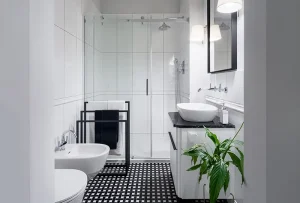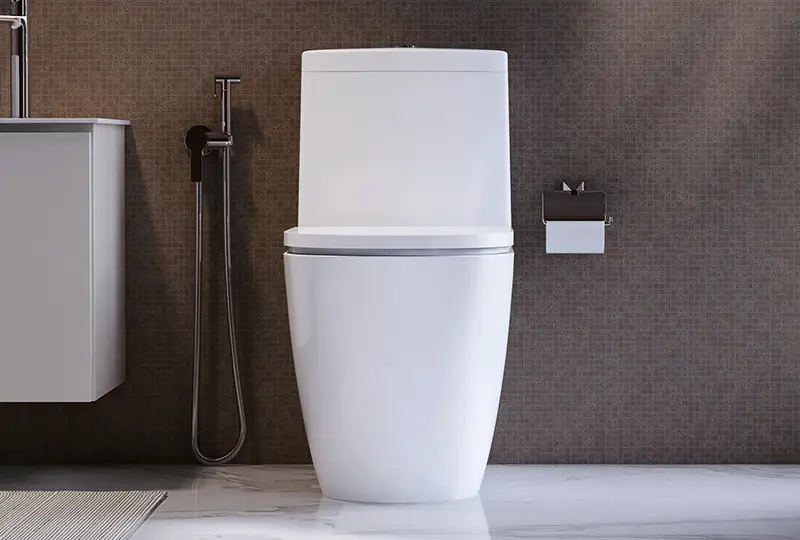What’s the Buzz About Bidets?
by Amanda Milewski
A Relatively Silent but Sanitary Boom is Underway in the Country
During the COVID-19 pandemic, with the supply of toilet paper dwindling, many panicked U.S. citizens turned to something standard in bathrooms in many parts of the world but just beginning to gain traction here in the United States — the bidet. Whether the trend was already taking hold or the pandemic solidified its popularity, conversations about bidets are booming, even in Carroll County.
Total disclosure: The pandemic was raging. I had two young adult children living and working from home, and our youngest was still in high school. The toilet paper supply at home and in stores was quickly dwindling. In panic mode, I ordered $20 toilet paper from China (which still hasn’t arrived) and a $60 bidet toilet seat attachment as a backup. Thankfully, I finally scored some toilet paper, and we didn’t end up using the bidet.
We weren’t alone. CNN reported that all bidets available through bidetking.com sold out during the pandemic, many before they arrived at the warehouse. Some estimates reflect a double to threefold increase in the bidet market. Bidet seat attachment maker Tushy reported revenue of $40 million in 2020 versus $8 million the previous year.
Although the pandemic has faded into the background, the bidet market continues to make gains. Bidetking.com reported a minimum annual growth of 20% and a close to 30% sales growth last year.
For the Uninitiated, What is a Bidet?
In a nutshell, the bidet provides a stream of water targeted at your backside to help you clean up after using the bathroom. Some models offer warm water. Some yield a moveable stream to target other private areas, while other models have varying pressures and oscillating streams.
Handheld bidet attachments and fixed bidet attachments that connect to your toilet seat are available. All provide the same function but with varying price points, installation methods and features.
Originating in France, bidets are now common throughout Europe, the Middle East, South Asia and some South American countries. Some sources suggest that bidets didn’t catch on in America because of their prevalence in brothels in France. American GIs fighting there during World War II made some assumptions, and the bidet was stigmatized for generations.
Has the Bidet Boom Reached Carroll County?
While not everyone is comfortable talking about their bathroom preferences, Carroll residents appear to be taking more interest in bidets.
In Eldersburg, Todd Swanson, president of Design Build Remodeling Group of Maryland, reports that more than half of customers install bidets in their bathroom remodels.
The company specializes in large-scale, high-end bathroom remodels with price tags ranging from $200,000 to $1 million. Swanson says he sometimes suggests installing a bidet, and sometimes clients request it. Some clients grew up using bidets; others have experienced them during their travels.
Eldersburg residents Dave and Vicky Blau wanted “all the bells and whistles” for their bathroom remodel. The project involved gutting the existing space “down to the studs,” she says. They opted for a bidet with a night light, heated seat, backrest and a remote control to automate the experience.
Vicky says that since she and Dave are retired, they wanted to enjoy living in their house now before feeling the need to downsize. Installing a bidet was part of the “enjoy-the-go” aspect.
Not new to the renovation process, Blau recalls everyone making fun of her when she wanted to install a pot filler on the wall next to her stovetop as part of a kitchen remodel. Maybe she’s ahead of the curve with the bidet as well.
Swanson says many clients install bidets in in-law suites or when they are thinking about aging in place. But he noted that younger, more affluent clients are also opting to install bidets.
The Nuts and Bolts of Bidets
According to Swanson, installing a freestanding bidet is similar to installing a toilet and is relatively easy. Some options require an electrical hookup — that’s usually where additional expenses come in — and the fixture itself.
Bidets, handheld sprayers and bidet seat attachments are available at many price points, ranging from less than $100 for existing toilet bidet attachments to more than $1,300 for a top-of-the-line freestanding seat bidet.
Swanson says a bidet pays for itself relatively quickly. The savings on toilet paper coupled with the low water usage can recoup the cost of the unit. “To my knowledge, there are no downsides to having a bidet,” Swanson says.
Easier on the Environment
 In addition to the increased hygiene of bidet use, which is helpful for moms who have just given birth and those suffering from hemorrhoids or urinary tract infections, bidets can help the environment by decreasing the amount of toilet paper and flushable wipes used.
In addition to the increased hygiene of bidet use, which is helpful for moms who have just given birth and those suffering from hemorrhoids or urinary tract infections, bidets can help the environment by decreasing the amount of toilet paper and flushable wipes used.
The exact numbers for toilet paper usage vary in the United States. No matter how much toilet paper we use, the environmental cost is high because of its manufacturing footprint. According to The World Counts, an online information provider focusing on the world population, consumer economy and global challenges, the 42 million tons of toilet paper used worldwide every year requires 712 million trees, 78 million tons of oil and 1,165 million tons of water.
Andrew Watcher, bureau chief of utilities for Carroll County, explains that toilet paper poses no environmental risk to the county’s wastewater treatment process since “toilet paper primarily decomposes into a pasty sludge almost immediately. Additionally, most of the pumping stations are equipped with grinders that further pulverize the wastewater flow into a fine sludge.”
Flushable wet wipes are a different story. Verified Market Research valued the flushable wet wipes industry at $2.6 million in 2023. Projections estimate an increase to $3.9 million by 2031.
“Wipes of any type — even those labeled as flushable — should not be flushed into the wastewater system,” cautions Watcher. “Wipes do not decompose into a sludge. They remain intact and tend to become entangled with fine tree roots that have entered the pipe systems via joints or cracks,” he explains. “Over time, these entanglements may expand into blockages that can and have resulted in sewer backups.”
If your home has a septic tank, you are responsible for costly repairs due to clogs from flushable wipes. While he doesn’t own a bidet, Watcher agrees that using bidets or bidet attachments makes environmental sense. TP isn’t going anywhere Although bidets are growing in popularity, we will always need toilet paper, even if we one day decide to follow Italy’s lead. In 1975, Italy made the bidet a legally required fixture in all buildings.
While cleaning up with toilet paper is ingrained in our collective psyche, that doesn’t mean there aren’t different or better ways to “enjoy the go” if we are willing to try them.
TP isn’t Going Anywhere
Although bidets are growing in popularity, we will always need toilet paper, even if we one day decide to follow Italy’s lead. In 1975, Italy made the bidet a legally required fixture in all buildings.
While cleaning up with toilet paper is ingrained in our collective psyche, that doesn’t mean there aren’t different or better ways to “enjoy the go” if we are willing to try them.

